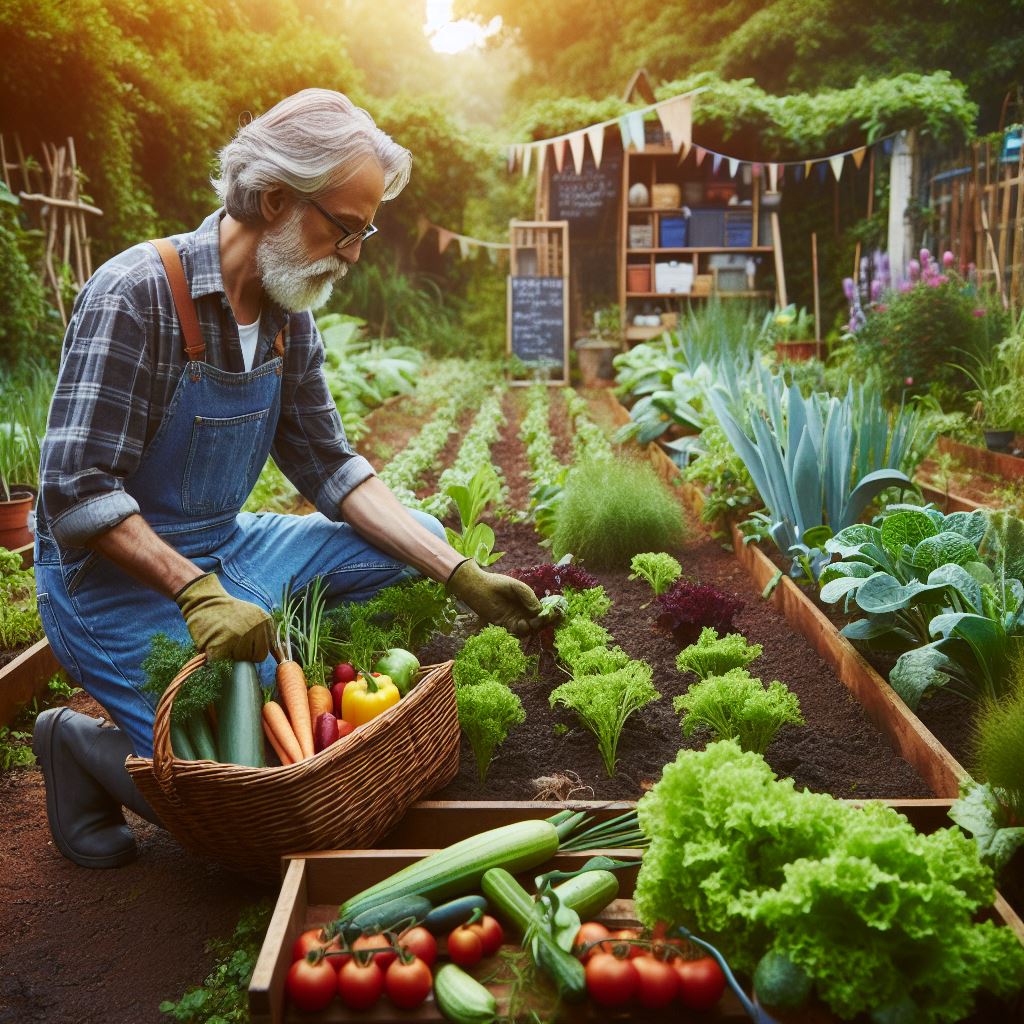Introduction
Community gardens are shared public spaces where residents gather to grow fresh produce, plants, and herbs.
These communal plots foster neighborhood engagement, provide green space in urban areas, and increase access to nutritious food.
As more people recognize the social, health, and environmental perks, these collaborative gardens are sprouting up across the country.
Participation in this grassroots movement is open to anyone eager to get their hands dirty.
The purpose of this blog post is to highlight the manifold benefits of joining or starting a community garden near you.
We will explore how they promote sustainability, bring neighbors together, educate gardeners of all ages, and donate bountiful harvests to local food banks.
From saving money to forging new friendships, community plots yield so much more than simply vegetables.
We will also provide tips on getting involved with community gardening efforts in your city or starting them yourself.
The community garden revolution is taking root nationwide, enriching neighborhoods, and nourishing residents.
Read on to discover how you can contribute and why you should join today.
Benefits of Community Gardens
A community garden offers numerous advantages that extend beyond just growing plants.
It plays a crucial role in enhancing food security, promoting healthy lifestyles, fostering community engagement, and improving mental well-being.
Let’s delve into the specifics:
Enhancing food security and access to fresh produce
- Community gardens allow individuals and families to grow their own healthy, organic food.
- They provide access to fresh produce, reducing reliance on heavily processed, nutrient-poor foods.
- By growing food locally, community gardens help reduce food transportation and carbon emissions.
- These gardens can also contribute to food security in neighborhoods with limited access to grocery stores and healthy food options.
Promoting healthy lifestyles and physical activity
- Being involved in a community garden encourages regular physical activity through gardening tasks.
- Gardening is a low-impact exercise that promotes flexibility, strength, and overall fitness.
- Engaging in physical activity outdoors, surrounded by nature, has positive effects on mental health.
- Community gardens create opportunities for intergenerational and family activities that promote healthy living.
Fostering community engagement and social connections
- Community gardens bring people with shared interests together, fostering a sense of belonging.
- Neighbors can collaborate, exchanging knowledge, skills, and resources, strengthening social ties.
- Gardening activities create spaces for communication, dialogue, and collaboration among community members.
- Community gardens often organize events that enhance community participation and social connections.
Improving mental well-being and overall quality of life
- Gardening and spending time in nature have been linked to reduced stress levels and improved mental health.
- Being part of a community garden provides opportunities for relaxation, self-expression, and creativity.
- Gardening can help alleviate symptoms of depression, anxiety, and isolation.
- Individuals who participate in community gardens often report an improved sense of well-being and quality of life.
Community gardens offer incredible benefits to individuals and the communities they belong to.
From enhancing food security and promoting healthy lifestyles to fostering community engagement and improving mental well-being, these gardens help create vibrant and resilient communities.
Transform Your Agribusiness
Unlock your farm's potential with expert advice tailored to your needs. Get actionable steps that drive real results.
Get StartedGet involved now and become part of this remarkable movement!
Read: Slow Food Movement: What’s the Hype?
How to Get Involved in Community Gardens
Researching and locating local community gardens
- Start by conducting online research to find community gardens in your area.
- Look for websites or social media platforms dedicated to community gardens.
- Check with local government or municipality websites for information on community gardens.
- Visit your local library and ask for any resources or directories on community gardens.
- Reach out to friends, neighbors, or colleagues who may already be involved in community gardens for recommendations.
- Attend local farmers markets or gardening events where you can gather information about community gardens.
Contacting the organizers or garden managers for participation information
- Once you have identified potential community gardens, gather contact information for their organizers or garden managers.
- Reach out to them via email or phone to express your interest in getting involved.
- Inquire about any specific participation requirements, such as membership fees or time commitments.
- Seek information about their gardening philosophy or goals to ensure compatibility with your own values.
- Ask for any upcoming events or meetings where you can learn more about the community garden.
Understanding any eligibility requirements or membership criteria
- Inquire about any specific eligibility requirements or criteria for becoming a member of the community garden.
- Check if there are any residency restrictions or age limitations for participation.
- Understand if there are any gardening experience prerequisites or if beginners are welcomed too.
- Ask about any financial obligations, such as annual dues or volunteer hour commitments.
- Ensure you understand and can meet any criteria before committing to join a particular community garden.
Assessing personal skills or interests that can contribute to the garden community
- Reflect on your own skills, interests, and experience that could be valuable in a community garden setting.
- Consider if you have prior gardening knowledge, landscaping skills, or design abilities.
- Assess if you enjoy working with others and can contribute positively to a collaborative gardening environment.
- Determine if you have any specific interests in areas like composting, organic gardening, or community outreach.
- Reflect on your availability and commitment level for regular gardening activities and maintenance.
Getting involved in a community garden can have numerous benefits, such as learning new gardening techniques, fostering connections with fellow gardeners, and contributing to a healthier and more sustainable community.
By researching and reaching out to local community gardens, understanding their requirements, and assessing your own skills and interests, you can find a community garden that aligns with your goals and become an active participant in the movement.
Remember, the journey of community gardening is not only about growing plants but also about nurturing a sense of belonging and shared responsibility within the community.
Read: Preserving the Harvest: Canning 101
Roles and Responsibilities in Community Gardens
Various tasks and responsibilities involved in community gardens
- Planting and maintaining the garden beds to ensure healthy growth and productivity.
- Watering the plants regularly and monitoring soil moisture levels to prevent dehydration.
- Removing weeds and pests to protect the plants and maintain a clean environment.
- Pruning and trimming plants to promote proper growth and prevent overcrowding.
- Harvesting ripe produce and distributing it among the community members.
Opportunities for different levels of involvement
Gardening Tasks
- Planting seeds, transplants, or seedlings in designated garden beds.
- Caring for plants by watering, weeding, and providing necessary nutrients.
- Harvesting fruits, vegetables, or herbs when they are ready for consumption.
Maintenance Tasks
- Regularly mowing the lawn and keeping the pathways clear for easy access.
- Pruning and trimming plants to maintain their health and aesthetic appeal.
- Repairing and maintaining garden structures such as fences, benches, and compost bins.
Administrative Tasks
- Organizing meetings and keeping track of community garden membership.
- Coordinating volunteer schedules and ensuring tasks are properly assigned.
- Managing finances, fundraising, and seeking grants or donations for garden improvements.
Importance of teamwork and cooperation in maintaining the garden
In order for community gardens to thrive, it is crucial for members to work together and support each other.
- Collaborating on planning and decision-making processes to allocate resources effectively.
- Sharing knowledge and expertise to help inexperienced gardeners learn and grow.
- Establishing clear communication channels to address any issues or concerns promptly.
- Encouraging a sense of inclusivity and diversity within the community garden.
- Promoting a positive and respectful environment where everyone can contribute and be appreciated.
By fostering an atmosphere of teamwork and cooperation, community gardens can become thriving green spaces that enhance the well-being of all participants and the wider community.
Read: Farm-Friendly Kids’ Meals Made Easy

Overcoming Challenges and Obstacles
Identifying common challenges faced by community gardeners
- Limited access to land for gardening due to urbanization and high property prices.
- Lack of knowledge and experience in gardening techniques and plant care.
- Difficulty in securing funding and resources for maintenance and development of community gardens.
- Issues with soil quality and contamination, especially in urban areas with industrial history.
- Challenges in managing conflicts and disagreements among community garden members.
Potential solutions and strategies to overcome challenges
- Collaborating with local government and nonprofits to secure land and funding for community gardens.
- Offering gardening workshops, classes, and mentorship programs to educate community gardeners.
- Engaging in fundraising initiatives and seeking sponsorships from businesses and community organizations.
- Implementing soil testing and remediation practices to ensure safe growing conditions.
- Establishing clear guidelines and conflict resolution mechanisms for handling disputes within the community garden.
Sharing success stories and lessons learned from experienced gardeners
- Alison, a community gardener, transformed a vacant lot in her neighborhood into a thriving vegetable garden by mobilizing local volunteers and seeking support from the city.
- Michael, a retired farmer, shared his knowledge and expertise with fellow community gardeners, resulting in increased crop yields and improved gardening techniques.
- The Riverside Community Garden successfully navigated a land lease negotiation, securing a long-term agreement with the city for their garden.
- Lisa, a seasoned gardener, emphasized the importance of continuous learning and experimentation to overcome gardening challenges.
- The Hamilton Community Garden implemented a conflict resolution committee, ensuring peaceful coexistence among garden members and fostering a sense of community.
Through highlighting these success stories and lessons learned, community gardeners can gain inspiration, motivation, and valuable insights into overcoming challenges and obstacles they may face in their own gardening journey.
Read: Root to Stem: Waste-Free Cooking
Tips for a Successful Community Garden
Planning and organizing the garden layout
- Start by assessing the available space and identifying the best spot for the community garden.
- Consider factors like sunlight, water access, and proximity to the community.
- Divide the garden into plots and assign them to individual gardeners based on their preferences.
- Plan pathways and communal areas to promote interaction and ease of movement within the garden.
- Include designated areas for composting and storage of tools and supplies.
Establishing clear communication channels among garden members
- Create a clear and accessible communication system to facilitate coordination and cooperation among gardeners.
- Utilize tools like a shared online calendar or a mailing list to keep everyone informed about important dates and garden activities.
- Hold regular meetings or social events to discuss garden updates, resolve conflicts, and foster a sense of community.
- Encourage open communication and active participation from all garden members.
- Establish a point of contact or a garden committee that can address any concerns or issues raised by the community.
Implementing sustainable gardening practices
- Emphasize the importance of organic gardening and avoid the use of harmful chemicals or synthetic pesticides.
- Promote water conservation by using efficient irrigation methods like drip systems or rainwater harvesting.
- Encourage companion planting to naturally control pests and enhance the health of the garden.
- Practice composting to reduce waste and improve soil fertility.
- Provide educational resources and workshops on sustainable gardening techniques for garden members.
Encouraging participation and inclusivity within the garden community
- Hold regular gardening workshops or training sessions to enhance gardening skills and knowledge.
- Organize community events or volunteer days to involve the broader community in the garden activities.
- Ensure accessibility for individuals with disabilities by providing raised beds or modified gardening tools.
- Promote diversity by encouraging people of different ages, backgrounds, and abilities to join the community garden.
- Create a welcoming and inclusive atmosphere where all members feel valued and included.
In a nutshell, a successful community garden requires careful planning, effective communication, sustainable practices, and a sense of inclusivity.
By following these tips, community gardeners can create a thriving and vibrant space for everyone to enjoy.
So let’s join the movement and start growing together!
Resources and Support for Community Gardens
Researching local government programs and initiatives supporting community gardens
- Contact your local government offices and inquire about any existing programs or initiatives that provide support for community gardens.
- Visit their websites, check for relevant information, and look for any guidelines or application processes.
- Attend community meetings or workshops where representatives may share details about available resources.
- Network with other community gardeners or join online forums to gather information and personal experiences.
Exploring grants, funding, and sponsorship opportunities for community garden projects
- Research local and national grants available for community garden projects.
- Check with nonprofit organizations, foundations, and corporations for funding opportunities.
- Develop a clear project proposal outlining the goals, benefits, and sustainability of your community garden.
- Highlight the impact your garden will have on the community, such as promoting healthy eating or educational programs.
- Approach local businesses or organizations for potential sponsorships, emphasizing the mutual benefits of collaboration.
Seeking advice and assistance from gardening organizations, extension offices, or master gardeners
- Reach out to gardening organizations in your area, such as horticultural societies or garden clubs.
- Attend their meetings, workshops, or events where experienced gardeners can provide guidance.
- Ask for recommendations regarding resources, materials, or techniques specific to your community garden.
- Contact nearby extension offices or agricultural universities for expert advice on soil testing and plant care.
- Consider consulting with master gardeners, who are trained volunteers knowledgeable in gardening practices.
- Master gardeners can offer guidance on plant selection, garden design, and overcoming common challenges.
By utilizing these resources and seeking support, your community garden project can thrive and make a positive impact.
Conclusion
Community gardens positively impact neighborhoods by bringing people together, providing green space, and increasing access to fresh produce.
These resident-run spaces foster deeper community connections, educate gardeners, and donate thousands of pounds of food annually.
Anyone can contribute to this meaningful movement.
Throughout this blog, we outlined the social, health, and environmental benefits of participating in or starting a community garden in your area.
Now is the time to get involved by volunteering at an existing site, joining the planning committee for a new garden, or spearheading an effort near you.
Even small actions like donating tools, supplies, or labor can make a tangible difference.
With active participation from passionate residents, we can spread the community garden movement to transform more spaces and lives across the country.
As an emerging nationwide trend that resonates with diverse populations, community gardening has the power to reshape our health, diets, and neighborhoods for the better.
Will you join your neighbors and play an active role?
Showcase Your Farming Business
Publish your professional farming services profile on our blog for a one-time fee of $200 and reach a dedicated audience of farmers and agribusiness owners.
Publish Your ProfileShare this post and start growing community in your own backyard.
Through grassroots efforts, we can cultivate change one vegetable at a time.




